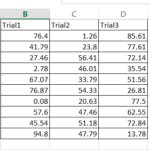Creating Permutations in Excel
Creating permutations in Excel involves generating all possible arrangements of a set of items. While Excel doesn’t have a built-in permutation function, you can achieve this by using formulas and techniques.
Here’s a step-by-step guide on how to create permutations in Excel:
Step 1: Understand Permutation Count
Firstly, to understand how many permutations you can have for a set of items, use the FACT function to calculate factorials, as the number of permutations of n items is n! (n factorial).
Step 2: Use Excel for Calculating Permutation Counts
If you have n items and want to choose r of them in order, use the PERMUT function to calculate the number of permutations. The syntax is =PERMUT(n, r).
For example, for 5 items chosen 3 at a time, in cell C1, you could use:
=PERMUT(5,3)
This calculates how many different ways you can arrange 3 items out of 5.
Alternative Method: VBA for Generating Permutations
For generating a list of all permutations, Excel’s built-in functions are limited. However, you can use Excel’s VBA (Visual Basic for Applications) to write a custom procedure for generating permutations.
- Press ALT + F11 to open the VBA editor.
- Insert a new module and write a VBA function to generate permutations.
- The VBA method involves more advanced programming techniques and is suited for users comfortable with coding.
Practical Considerations:
Directly listing permutations in Excel using formulas for more than a few items is impractical due to the exponential growth of permutation counts.
For small sets, manual permutation is feasible, but for larger sets, consider using VBA or specialized software designed for combinatorial analysis.



Leave a Reply